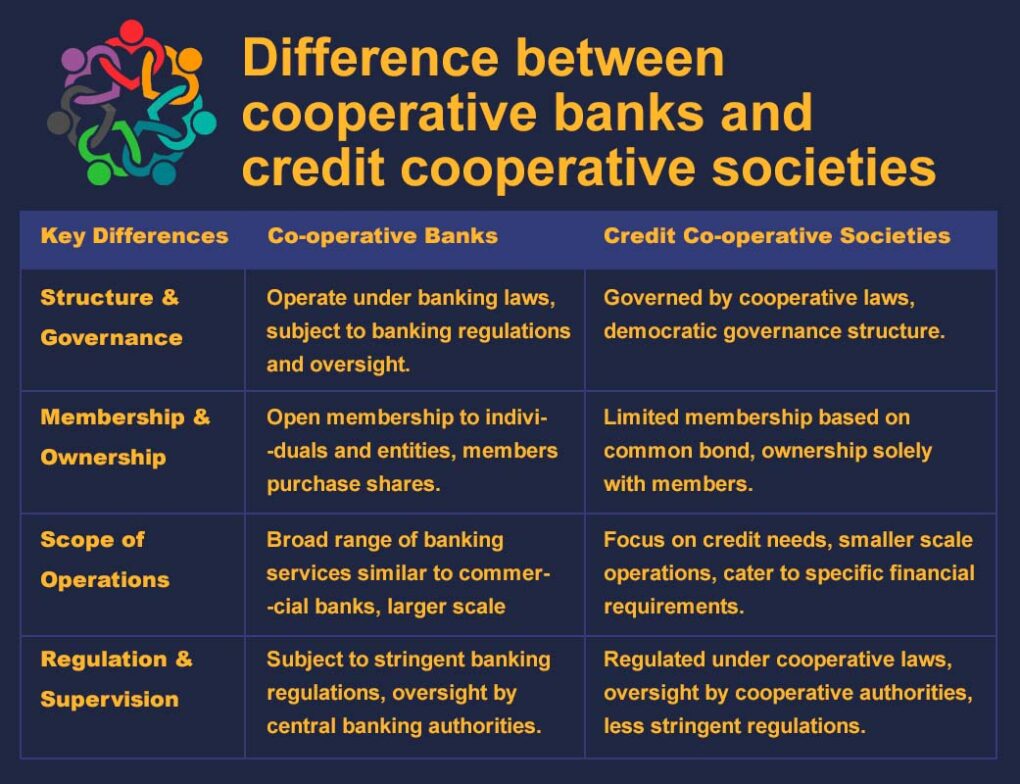Co-operative Banks vs. Credit Co-operative Societies
In the world of banking and finance, institutions like co-operative banks and credit co-operative societies play a significant role, particularly in serving the financial needs of communities and individuals. While both are rooted in the cooperative philosophy, there are nuanced differences between the two.
Understanding these disparities is crucial for individuals seeking financial services and for those interested in cooperative models of banking. Let’s delve into the variances between co-operative banks and credit co-operative societies.

Structure and Governance
Co-operative Banks: One of the primary distinctions lies in their structure and governance. Co-operative banks typically operate under the regulatory framework of banking laws prevalent in the country they are situated in.
They are registered as banks and function as such, albeit with a cooperative ownership structure. This means they are subject to banking regulations and oversight by central banking authorities.
Credit Co-operative Societies: On the other hand, credit co-operative societies operate more on a grassroots level. They are often smaller in scale and are governed by cooperative laws rather than banking regulations.
These societies are formed by individuals coming together to pool their resources for mutual financial assistance. Their governance is democratic, with members having a say in decision-making processes.
Membership and Ownership
Co-operative Banks: Membership and ownership structures differ significantly between co-operative banks and credit co-operative societies.
In co-operative banks, membership is typically open to individuals and sometimes even to other entities such as companies or associations.
Members usually have to purchase shares to become part-owners of the bank, entitling them to certain rights such as voting in board elections and receiving dividends.
Credit Co-operative Societies: Credit co-operative societies, however, operate on a principle of limited membership. They are often formed by individuals who share a common bond, such as residing in the same locality or belonging to the same profession or community.
Membership in credit co-operative societies is restricted to those who meet specific criteria set forth by the society, and the ownership lies solely with the members.
Scope of Operations
Co-operative Banks: Co-operative banks usually have a broader scope of operations compared to credit co-operative societies.
They offer a wide range of banking services akin to traditional commercial banks, including savings and current accounts, loans, mortgages, and other financial products. They also offers Daily deposit schemes to build saving habit.
Some larger co-operative banks may even have branches across multiple regions or states.
Credit Co-operative Societies: Credit co-operative societies, on the other hand, tend to focus on meeting the credit needs of their members.
While they may offer basic banking services like savings and deposit accounts, their primary function is to provide affordable credit facilities to their members.
These societies often operate on a smaller scale, catering to the specific financial requirements of their limited membership base.
Regulation and Supervision
Co-operative Banks: Regulation and supervision represent another notable contrast between co-operative banks and credit co-operative societies.
Co-operative banks, being classified as banks, are subject to stringent banking regulations imposed by central banking authorities or financial regulatory bodies in their respective countries.
These regulations ensure stability, transparency, and adherence to prudential norms in banking operations.
Credit Co-operative Societies: Credit co-operative societies, however, are primarily regulated under cooperative laws rather than banking regulations.
While they may still be subject to oversight by cooperative authorities or regulatory bodies, the regulatory framework is typically less stringent compared to that governing banks.
This can sometimes lead to variations in operational standards and risk management practices among different credit co-operative societies.
Do you know?
You can make money using Credit card.
Many credit cards offer cashback rewards on certain purchases, such as groceries, gas, or travel. By choosing a card with a high cashback rate on your typical expenses, you can earn a percentage of your spending back in the form of cash or credit.
If you don’t know about credit card, read my following article – What is Credit Card & How to use it?
Summary
In essence, while both co-operative banks and credit co-operative societies share the fundamental principles of cooperation and mutual assistance, they exhibit distinct differences in structure, governance, membership, scope of operations, and regulation.
Co-operative banks function more akin to traditional banks, offering a comprehensive range of banking services to a broader customer base and operating under strict banking regulations.
On the other hand, credit co-operative societies are characterized by their grassroots origins, limited membership, focus on providing credit facilities to members, and regulation under cooperative laws.
Understanding these disparities is essential for individuals seeking financial services tailored to their needs and preferences. Whether opting for the comprehensive services of a co-operative bank or the community-oriented approach of a credit co-operative society, both models offer unique benefits rooted in the principles of cooperation and mutual empowerment.
Frequently Asked Questions
Q. What is the primary objective of co-operative banks?
Answer: The primary objective of co-operative banks is not profit maximization, but to offer the best financial services to their members.
Q. How do co-operative banks differ from commercial banks in terms of interest rates?
Answer: Co-operative banks generally offer higher interest rates on deposits and lower interest rates on loans compared to commercial banks.
Q. Who owns co-operative banks?
Answer: Co-operative banks are owned by their members, unlike commercial banks which are owned by shareholders.
Q. How are co-operative banks managed?
Answer: Co-operative banks are managed by elected members, whereas commercial banks are managed by paid professionals.
Q. What is the regulatory framework for credit co-operative societies?
Answer: Credit co-operative societies are regulated under the Cooperative Societies Act and do not come under the direct purview of the Reserve Bank of India, unlike co-operative banks.
Q. What is the minimum capital requirement for co-operative banks?
Answer: To be considered a co-operative bank, the co-operative society must have a minimum net worth of ₹1 lakh, which is higher than the requirement for credit co-operative societies.
Q. Are deposits with credit co-operative societies covered by deposit insurance?
Answer: No, deposits with credit co-operative societies are not covered by deposit insurance from the Deposit Insurance and Credit Guarantee Corporation (DICGC), unlike deposits with co-operative banks.
Q. What is the key distinction between the objectives of co-operative banks and credit co-operative societies?
Answer: Co-operative banks aim to provide the best financial services to their members, while credit co-operative societies are focused on providing financial accommodation to their members without performing full-fledged banking activities.


